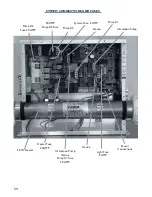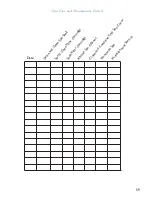
28
Example: At low total alkalinity levels, the water’s pH easily drifts, making frequent pH adjust-
ments necessary and more chemical treatment expense.
On the other hand, a high total alkalinity level keeps the waters pH rigidly fixed. If pH adjust-
ment is necessary, you will need unusually large amounts of treatment chemicals to change the
water’s pH.
RECOMMENDED RANGE - 80 to 120 PARTS PER MILLION (PPM)
POTENTIAL PROBLEMS:
1.
pH difficult to maintain. If total alkalinity is too low, pH will drift.
2.
Corrosive tendencies. If total alkalinity is too high:
• pH difficult to adjust (it remains fixed.)
• Cloudy water.
• Potential for scaling.
• High pH and low sanitizer efficiency.
TESTING: WEEKLY
ADJUSTING TOTAL ALKALINITY
Total Alkalinity can be raised with Alkalinity Increaser, or sodium bi-carbonate at the
manufacturer’s recommendation for dosage.
CALCIUM HARDNESS
Calcium hardness is the amount of dissolved calcium in your spa’s water. Too little calcium in
the water will etch plaster surfaces, too much will leave deposits on surfaces and equipment.
RECOMMENDED RANGE: 125-150
POTENTIAL PROBLEMS
Calcium Hardness Too Low:
• Some surfaces may be etched.
• May lead to equipment corrosion.
Calcium Hardness Too High:
• May contribute to cloudy water.
• Scaling of surface, piping and equipment.
ADJUSTING CALCIUM HARDNESS
Raise hardness by the addition of calcium chloride. Decrease calcium hardness by draining spa
and replacing with water containing lower levels of calcium hardness.
DISINFECTANT
Brominating Tablets, Granular Bromine and Granular Chlorine are popular disinfectants and are
particularly well suited to compliment your ozone purification system spa. They are also very
suitable products in water with elevated temperatures.
Brominating Tablets and Granular Bromine are effective as a spa water sanitizer and disinfectant.
Follow manufacturer’s directions for proper dosage. It is recommended to
maintain
an active
bromine residual of 2.0 to 4.0 ppm.
Granular Chlorine (Dichlor Dihydrate, Lithium Hypochlorite), is designed to dissolve quickly and
completely, provide a steady source of available chlorine to control the growth of algae, kill
bacteria and destroy organic contaminants. It is recommended to
maintain
a chlorine residual of
between 1.0 and 3.0 ppm.











































